Exactly 70 years ago, on September 8, 1946, in Moscow on Red Square, in accordance with the order of the Minister of the Armed Forces of the USSR, a parade march of the 4th Guards
tank Kantemirovsky division. This was the first and only time when a whole tank division took part in the parade in the center of Moscow. The phrase "armor is strong and our tanks are fast" refers to this parade in full. In the parade, which lasted more than three hours, almost a thousand armored fighting vehicles took part, this is more than the number of Soviet tanks participating in the battle of Prokhorovka. This parade was the first official celebration of Tanker Day in our country.
Tankman Day was established by the Decree of the Presidium of the USSR Supreme Council of 1 July 1946 to commemorate the great merits of armored and mechanized troops in defeating the German fascist troops in the years of World War II, as well as the merits of domestic tank builders in equipping the USSR armed forces with armored vehicles, especially in difficult times war time. For example, the cumulative production of only T-34-76 and T-34-85 tanks exceeded 65,8 thousands of units. Up to 1980, the holiday was celebrated on September 11, the date was not chosen by chance. On this day in 1944, the Soviet troops were able to achieve significant success during the East Carpathian operation, in which tank units played a significant role. In 1980, also by decree of the Presidium of the Supreme Soviet of the USSR, a new date for celebrating the Day of the Tankman was established, which is observed today - the second Sunday of September.
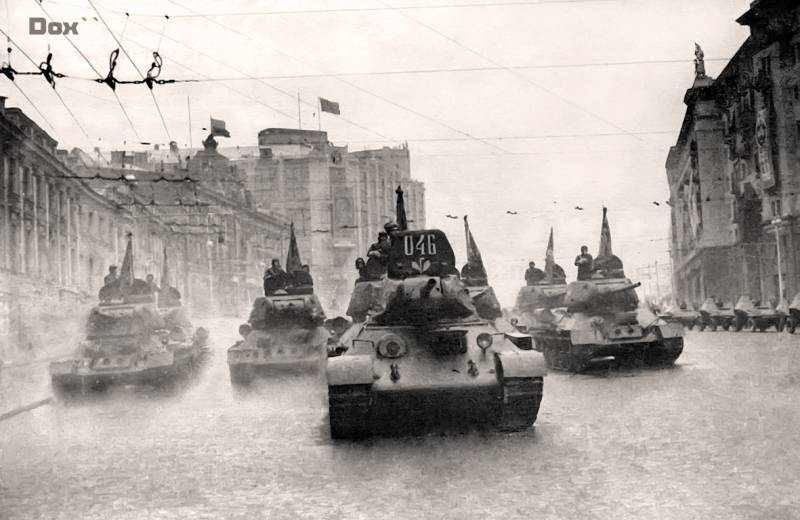
The first Day of the tanker in the USSR was celebrated on a grand scale. On the pavement of the main square of the state, columns of menacing armored vehicles of an entire tank division, direct participants in the recently battered battles, passed in even rows. The honor of marching at the ancient walls of the Moscow Kremlin with a special decree of Joseph Stalin was awarded to the soldiers of the renowned 4 Guards Tank Kantemirovskaya division. Fighting vehicles lined up on the central streets of Moscow before dawn, so that even before the parade, Muscovites were able to look at military equipment and communicate with the soldiers of the division.
Parts of the celebrated division marched through Red Square, observing the structure adopted for the combat mission. The reconnaissance divisions of the division were the first to enter the square, then the vanguard passed, then, protecting the main forces of the division on the march, the head march passed. As part of the main forces of the division, self-propelled and rocket artillery, motorized infantry, and the reserve of the division were represented by heavy tanks. In general, the T-8-1946 medium tanks took part in the September 34 parade of September, which became the main ones in the Red Army since 85, as well as the latest X-1944 heavy tanks. Self-propelled artillery was represented by heavy ACS IAS-3, light 152-mm self-propelled guns - SU-76 and anti-tank self-propelled guns SU-76.
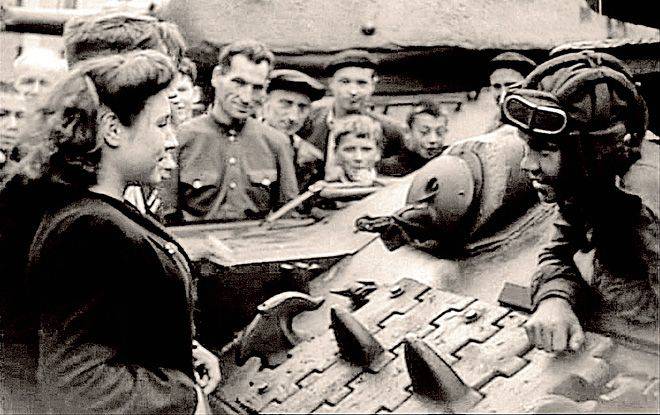
Was presented at the parade and exotic. In particular, armored anti-aircraft self-propelled units on the ZSU-37 tracked chassis passed in the parade formation. These combat vehicles in the 1944-1946 years were released in an extremely small series - 75 units. The ZSU-37, built on the basis of the ACS SU-76, was the first production armored ZSU on a tracked chassis in the Soviet Union. This combat vehicle was ideal for protecting mobile units from the air. Its main weapon was the 37-mm anti-aircraft gun 61-K, which was installed in a turret with a circular rotation.
The 4-I Guards Tank Kantemirovsky Order of Lenin The Red Banner Division was not chosen by chance for the parade. The division was considered one of the most efficient and combat-ready in the Red Army and was stationed in Naro-Fominsk near Moscow. The division was formed during the war years near Stalingrad in June 1942, as the 17 tank corps. In essence, the division became the successor of the unit, which received the baptism of 26 on June 1942 on the banks of the Don River, west of Voronezh. It is curious that after the war the publishing house “Children's Literature” published the story of Vladimir Lyalenkov “The Famous Tank” about the renowned battle path of the Kantemirovskaya tank division. This book tells about the first battles of the 17 tank corps in the Voronezh region - near the Kastornoye, Gorshechnoye and Stary Oskol railway stations.
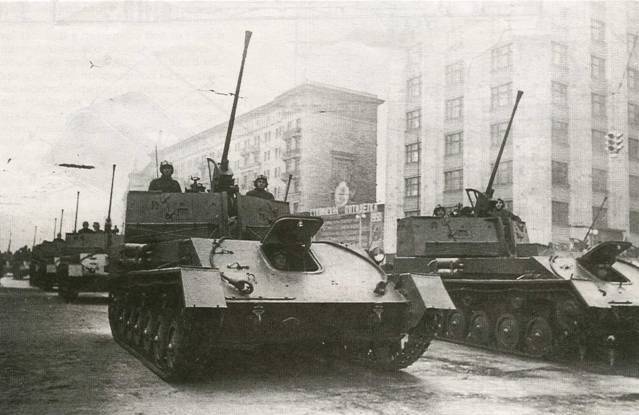
For the difference in the battles against the Nazi troops in the Middle Don region, the 17 tank corps was transformed into the 1943 Guards in January 4, and received the honorary title Kantemirovsky for the differences in the battles at Kantemirovsky. In July-August 1943, the corps took part in stubborn battles in the Belgorod-Kharkiv direction of the Kursk Bulge. For courage and heroism, which were shown by corps fighters during the liberation of a number of cities in the territory of right-bank Ukraine: Zbrazh, Tarnopol and Shepetivka in April 1944, the corps was awarded the Order of the Red Banner, and then the Order of Lenin was awarded for the liberation of the city of Krakow. The 4 Guards Kantemirovsky Tank Corps reached the Elbe River among the first Soviet units, and also participated in the capture of Dresden. Then his units made a swift raid into Czechoslovakia. Having received the baptism of fire on the banks of the Don near Voronezh, the corps completed its battle route in honor of Melnik, north of Prague, with honor, this happened on May 11 of the year 1945. 14 June 1945 of the Corps was reorganized into the 4 Guards Tank Division Kantemirovskaya Division, which 13 of September 1945 became part of the troops of the Moscow District with the redeployment of units in the city of Naro-Fominsk.
During the Great Patriotic War, the Supreme Commander IV Stalin declared gratitude to the personnel of this tank corps for excellent actions as many 18 times, and Moscow saluted the Kantemirovs in honor of their victories. During the war, 32 soldier divisions were awarded the title Hero of the Soviet Union (5 of them were forever enrolled in the division lists), six soldiers became full holders of the Order of Glory, more than 21 thousands of soldiers and commanders were awarded various orders and medals. In honor of this tank division in Moscow, Kantemirovskaya street and the Kantemirovskaya metro station were named. Street Guardsmen Kantemirovtsev there in Kramatorsk, Donetsk region.
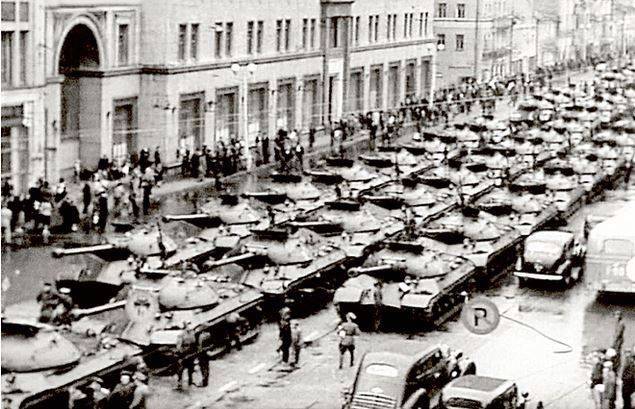
The tank avalanche of the division, which was continuously passing by Lenin’s Mausoleum for more than three hours on September 8 of the year 1946, caused a lot of trouble to the city’s utilities. After the parade, it turned out that the Church of St. Basil the Blessed due to the strong vibration was damaged, although insignificant, but repairs still had to be done. A similar situation was with some buildings from the housing stock of the capital. Why such a large-scale parade was needed, we can only guess today. It is unlikely that the only reason was the establishment of a new holiday - the Day of the Tankman. It is possible that the parade was a demonstration of military power and was intended to opponents of the USSR. It was a peculiar response of Moscow to the recent nuclear bombings by the Americans of Hiroshima and Nagasaki, as well as Churchill's famous Fulton speech, in which the USSR was called a "systemic opponent and enemy" and which, in fact, marked the beginning of the Cold War.
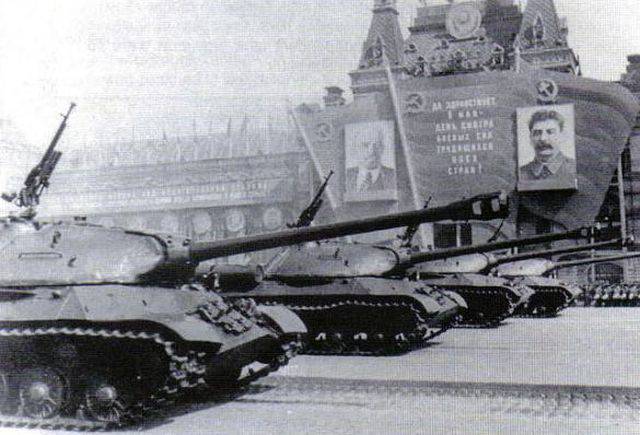





Information